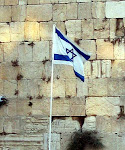By Hana Levi Julian
It is the first Antonius Pius coin ever found in Israel and was discovered by Alexis Whitley and her friend, on one of the hottest days of the summer. The two were clearing away dirt and rocks at the Bethsaida site when suddenly, Alex spotted the sparkle of a coin as it slipped down.
 Unaware of its significance, it took a while for Whitley to understand why excavation director Dr. Rami Arav immediately had her pose with the coin as photographers raced to the site.
Unaware of its significance, it took a while for Whitley to understand why excavation director Dr. Rami Arav immediately had her pose with the coin as photographers raced to the site.The coin, which Arav described as a discovery of Biblical dimensions, weights 7 grams of 24-karat gold – 97.6 percent gold, to be exact. It depicts the portrait of Antonius Pius, a Roman emperor who rules from 138-161 CE.
“Not every job that is boring has boring results,” Arav chuckled, when asked in an interview with Israel National News how he managed to stay focused on one site for the past 24 years. “Sometimes the results are fascinating.”
Arav, a professor at the University of Nebraska, said the coin was issued to celebrate Pius' designation of consul for a second time, which according to historical records took place in the summer of 138 CE. He noted that Pius' ascension to consul should have been indicated with an announcement on the flip side of the coin – but instead, the coin shows a portrait of the goddess Pietas – which the chief archaeologist said may have been a rare and valuable misprint. “Somebody in the Roman Imperial mint goofed. It is like having a rare and mistaken silver dollar,” Arav explained.
The coin also supports the theory that Pius embraced the Jewish population in Rome, unlike his father, who brutally oppressed the Jewish revolts. Pius is considered to have been a personal friend of Rabbi Yehudah (Judah) the Prince, creator of the Mishnah.
Bethsaida was founded as a capital of the ancient kingdom of Geshur and was the birthplace of at least three Christian apostles – Peter, Andrew and Philip. The ancient town is located at Park HaYarden, north of Lake Kinneret, also known as the Sea of Galilee. The site, discovered by Arav in 1987, has seen 24 seasons of excavations thus far.
Other finds over the past years have included a golden earring, an Athenian tetradrachm, a small Egyptian figurine (Pataekos) and common cooking pots.
 The golden earring was made of two pieces comprised of the head of an unidentified animal, decorated with small gold balls, with gold and silver twisted filigreed strings, soldered together with a gold strap.
The golden earring was made of two pieces comprised of the head of an unidentified animal, decorated with small gold balls, with gold and silver twisted filigreed strings, soldered together with a gold strap.The tetradrachm, a find which relates to the Persian period(450-330 BCE), dates back to approximately 450 BCE, according to a post on the Bethsaida excavation web site. The small figurine depicting the Egyptian god Pataekos was unearthed from beneath a 10-cm level of sediment of red burnt soil at the dig in 1994. Although most of the blue glazing was faded or peeled away, noted Arav at the time, “a few deposits under the right arm and under the neck indicate its original turquoise color.”
A globular cooking pot was also found at the site, one of the most common that exists in the excavation of the Hellenistic-Roman periods in the Land of Israel. The globular pot, equipped with two handles that emerge from the rim and were attached to the shoulders, was a common find at the site, said Arav.
He added that the coin, as well as all the other finds at the Bethsaida dig, remain the property of the State of Israel. “It is part of the heritage of this country,” he said. “Soon after the professional publication of the coin it will go to the Israel Antiquities Authority and I believe that it will be on display in a museum.”
The Bethsaida Excavation is being carried out by a consortium of 20 universities and colleges worldwide, Arav explained. Among the institutions involved are American, European, Australian and Israeli universities, headed by the University of Nebraska at Omaha.








No comments:
Post a Comment